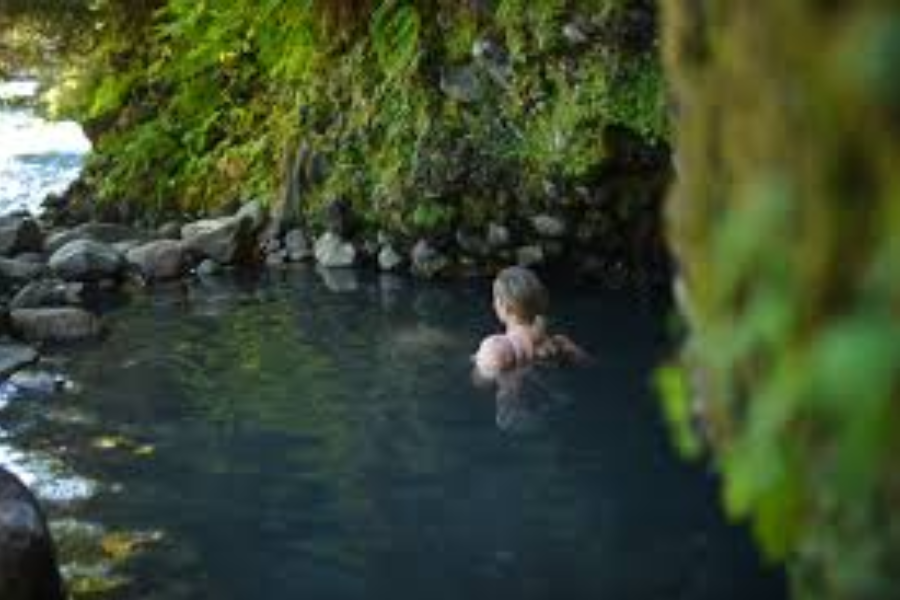Bigelow Hot Springs, also known as Deer Creek Hot Springs, is a hidden gem nestled along the northern bank of the McKenzie River in the Willamette National Forest, Oregon. Located approximately 60 miles east of Eugene, this primitive, rock-walled soaking pool offers a serene escape for those seeking to relax in mineral-rich geothermal waters amid lush ferns and rushing river views. With water temperatures averaging 102–104°F in summer and fall, Bigelow provides a tranquil, clothing-optional experience, though its small size (fitting 2–6 people) and seasonal temperature fluctuations make timing key. As of July 2025, this free, undeveloped hot spring remains a favorite for locals and travelers exploring the Cascade Range. This SEO-optimized guide covers Bigelow Hot Springs’ history, access, activities, preparation tips, and more, ensuring a rejuvenating visit to this Pacific Northwest oasis.
History and Geological Significance
Bigelow Hot Springs, situated in the volcanic Cascade Range, owes its existence to geothermal activity beneath the Willamette National Forest. The spring emerges at approximately 141°F from a shallow cave, cooling to 85–104°F in a man-made pool lined with riverside rocks and coarse sand. Geological studies, such as Lauren S. Forcella’s 1981 report, indicate the water is sodium chloride-based, with high mineral content (2,650 ppm dissolved solids) including chloride (1,148 mg/L), sodium (540 mg/L), and sulfur (102 mg/L), contributing to its therapeutic properties. The pool’s location near the McKenzie River, which originates in the high Cascades, causes seasonal cooling when river levels rise in winter and spring, submerging the pool with cold water. Historically, the site has been a local retreat, referred to as Deer Creek or McKenzie Hot Springs, with no formal development, preserving its natural, rustic charm.
Location and Access

Geographic Details
- Location: Willamette National Forest, Blue River, OR, near McKenzie Highway 126 (GPS: 44.2387, -122.0594).
- Proximity: 60 miles east of Eugene, 90 miles west of Bend, 4.4 miles northeast of Belknap Hot Springs, and 10 miles from Terwilliger (Cougar) Hot Springs.
- Terrain: Forested riverbank with lush ferns, rocky trails, and a gravelly pool partially set in a cave. Elevation is 1,700–2,000 feet.
- Nearby Attractions: McKenzie River Trail (hiking/biking), Belknap Hot Springs Resort (4.4 miles), Terwilliger Hot Springs (10 miles), Toketee Falls (60 miles), and Crater Lake National Park (100 miles).
Getting There
- From Eugene: Drive 54 miles east on OR-126 (McKenzie Highway) toward Sisters. After passing Belknap Springs, turn left onto Forest Road 2654 (Deer Creek Road), drive 0.2 miles, cross a one-lane bridge, and park in the dirt lot on the right (GPS: 44.241, -122.058). Follow a 200–300-yard dirt trail downstream along the McKenzie River to the springs.
- From Bend: Take US-97 N to US-20 W for 50 miles, merge onto OR-126 E for 15 miles, then turn right onto Forest Road 2654. Note: OR-242 is closed in winter, extending travel time.
- Road Conditions: Forest Road 2654 is paved and accessible by any vehicle in dry conditions. Avoid after heavy rain due to mud or washouts; check Willamette National Forest updates (fs.usda.gov/willamette) or call 541-822-3381.
- Public Transit: No direct service. Greyhound to Eugene, then rent a car or use a rideshare (Uber/Lyft, $80–$120 one-way). Guided tours to nearby Belknap Hot Springs may include Bigelow; check Eugene Cascades & Coast (eugenecascadescoast.org).
- Trail Access: From the parking lot, cross the road, take the left fork at the trailhead (marked by a day-use sign), and follow the 200–300-yard dirt path along the river. The trail is uneven with rocks and roots, not suitable for wheelchairs or limited mobility.
Access Notes
- Hours: Open daily, 6 a.m.–6 p.m., for day use only. Nighttime soaking is prohibited by Willamette National Forest rules.
- Fees: Free, unlike nearby Belknap ($12/hour) or Terwilliger ($7/day).
- Parking: Small dirt lot fits ~10 vehicles. Arrive early on summer weekends to avoid crowds.
Activities at Bigelow Hot Springs
Soaking
The main attraction is a single, rock-walled pool (8×13 feet, 1–3 feet deep) with a sandy, gravelly bottom, partially set in a fern-lined cave where the spring emerges. The pool fits 2–6 people, with the warmest water (up to 104°F) near the cave’s source. Summer and fall offer optimal soaking at 102–104°F, while winter and spring can drop to 80–90°F due to McKenzie River overflow. Clothing is optional, and nudism is common, especially midweek when crowds are lighter. The sulfur smell, typical of geothermal springs, is noticeable but not overpowering.
Nature Observation
The lush forest setting, with ferns draping the cave and the McKenzie River rushing by, creates a serene backdrop. Wildlife includes deer, birds (e.g., kingfishers), and occasional otters. The pool’s proximity to the river allows for cold plunges, enhancing the hot-cold therapy experience.
Photography
Bigelow’s fern grotto, river views, and steam rising from the cave make it a photographer’s delight. Use a wide-angle lens (16–35mm) for landscapes or a macro lens for fern and rock details. Early morning or late afternoon light softens shadows for optimal shots. Avoid tripods on uneven rocks to prevent slips.
Nearby Recreation
- McKenzie River Trail: A 26-mile trail for hiking, biking, or running, accessible from the parking lot, with waterfalls and scenic views.
- Belknap Hot Springs: 4.4 miles away, offering manicured pools, lodging, and gardens ($12/hour, belknaphotsprings.com).
- Terwilliger (Cougar) Hot Springs: 10 miles away, with six tiered pools (85–112°F, $7/day, clothing optional). Note: Forest Road 19 may close due to rockslides.
- Toketee Falls: 60 miles south, a 113-foot waterfall with a short hike.
- Fishing and Rafting: The McKenzie River is renowned for fly fishing and whitewater rafting; book tours in McKenzie Bridge.
Best Times to Visit
- Optimal Seasons: Late spring (May) to early fall (September–October) for warm water (102–104°F) and pleasant weather (60–80°F). Summer weekends can be busy, so midweek visits ensure solitude.
- Avoid: Winter (December–March) and early spring (April) when high river
